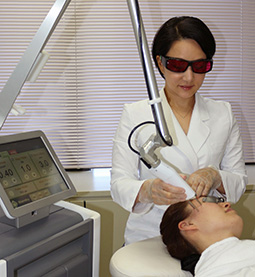Study suggests that a picosecond Nd:YAG laser can be a safer and more effective treatment for Asian patients.
Wausau, WI (October 8, 2018) – Solar lentigines, a form of benign epidermal hyperpigmentation, are a serious concern for aging skin in the Asian population. Common methods of treatment include quality‐switched (QS) lasers, long pulse lasers, and intense pulsed light, however there is a high incidence of adverse effects such as post-inflammatory hyperpigmentation in darker skin types with these methods.

A clinical report, published in Lasers in Surgery and Medicine (LSM), the official journal of the American Society for Laser Medicine and Surgery, Inc. (ASLMS), evaluates a picosecond Nd-YAG 532nm laser for treating solar lentigines in Asian skin.
The study, conducted by Kei Negishi, MD., PhD., Hirotaka Akita, MD., PhD. and Yukiko Matsunaga, titled “Prospective study of removing solar lentigines in Asians using a novel dual‐wavelength and dual‐pulse width picosecond laser,” was selected as Editor’s Choice in the October 2018 issue of LSM.
Picosecond lasers are used to remove tattoo inks, various kinds of benign pigmentary problems, acne and wrinkles with high efficacy and lower incidence of adverse effects.
“To the best of our knowledge, this is the first report of a prospective study to remove solar lentigines in darker skin types using a picosecond (PS) laser that includes histological evaluation using light and electron microscopy,” said Negishi. “Our study results not only showed safer and more effective clinical results with the PS Nd:YAG laser 532-nm compared to previous studies of nanosecond domain quality-switched (QS) lasers, but also showed the histological differences between the PS laser and a QS laser.
In addition, our research suggested an ideal immediate skin reaction with the PS laser; slight whitening change to the lesion. Using this as a preferable endpoint determination may be a key to take advantage of the photo-acoustic effect of the PS laser for removing solar lentigines safely and effectively from Asian patients.”
Dr. Kei Negishi focuses her research and practice on minimally invasive treatments for darker skin types, with a concentration on minimizing complications while extracting maximum efficacy using laser, light, and other energy-based devices. A specialist in treating pigmented lesions, she has completed pioneering work with multiple device modalities, with a recent focus on picosecond lasers. Her medical specialty is in Plastic and Reconstructive Surgery, and she completed her Ph.D. in Dermatology. Currently, she serves as Associate Professor of the Institute of Geriatrics of Tokyo Women’s Medical University and as a Council Member of the Japanese Society for Aesthetic Dermatology.
Editor’s Choice is an exclusive article published in LSM, the official journal of the ASLMS. View the complete manuscript.
The American Society for Laser Medicine and Surgery, Inc. (ASLMS) is the largest multi-disciplinary professional organization, dedicated to the development and application of lasers and related technology for health care applications. ASLMS promotes excellence in patient care by advancing biomedical application of lasers and other related technologies worldwide. Currently, ASLMS has over 4,000 members, including physicians and surgeons representing more than 51 specialties, physicists involved in product development, biomedical engineers, biologists, nurses, industry representatives and manufacturers. For more information, visit aslms.org.